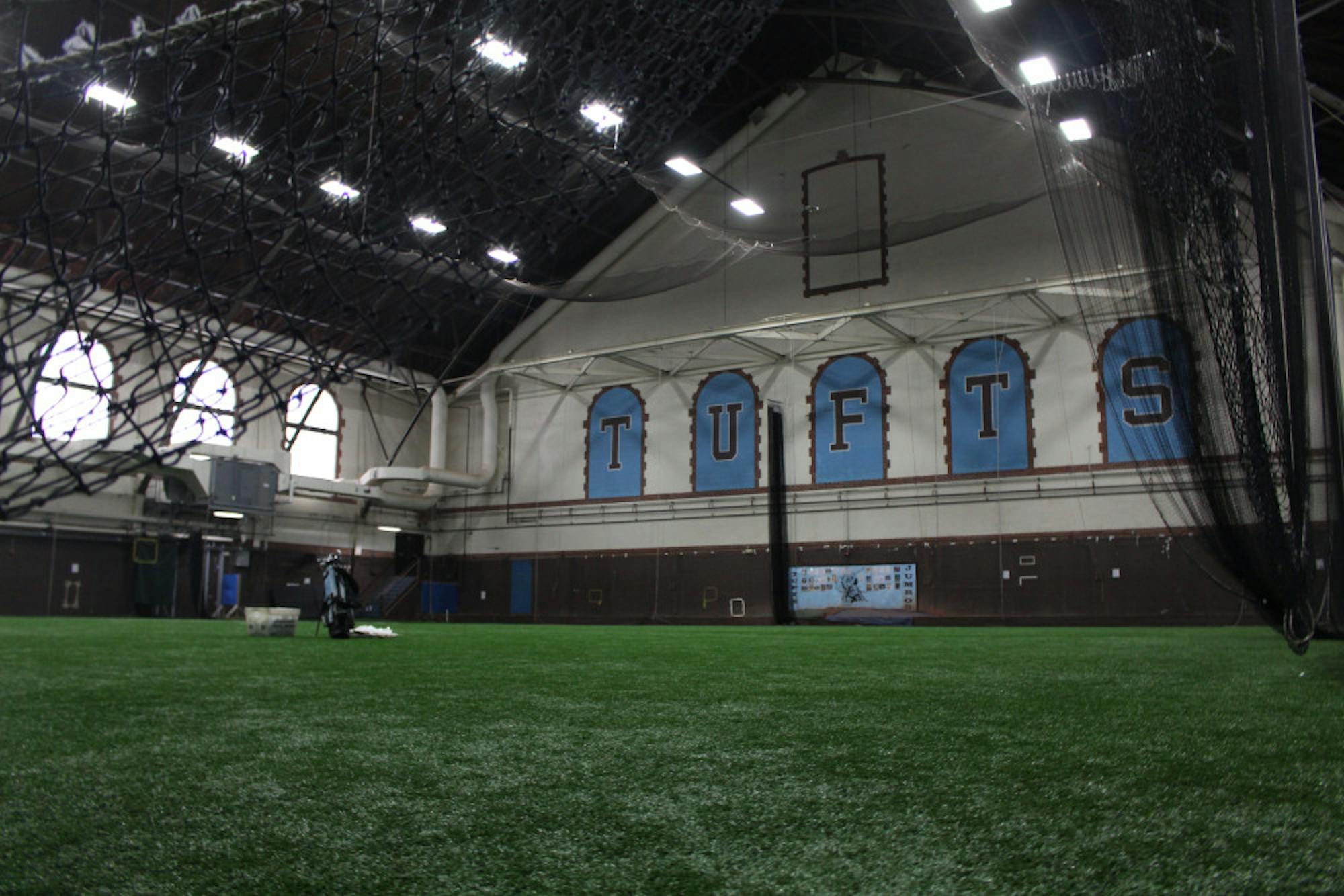The Tufts Athletics Department completed the installation of a field turf surface in Carzo Cage in December, which promises to provide several teams with safer and more realistic conditions during their winter training.
“The previous surface was almost 20 years old and was long past its period of usefulness,” Director of Athletics John Morris said. “We are very excited to have replaced it with a turf surface that provides a better space for our club and intramural programs to use, as well as gives our spring sports teams a place to practice indoors in February and March prior to the start of their seasons.”
Representatives from R.A.D. Sports finished the week-long process of laying 21,720 square feet of turf over the old synthetic track on Dec. 17, 2019. They began by covering the track, which was installed in 2002, with a padded surface in order to create a cushioned layer below the turf.
The resurfacing cost the Athletics Department $145,000 and was the result of a competitive bidding process, according to Executive Director of Media Relations Patrick Collins.
The turf installed is known as True Hop, a baseball- and softball-specific model that can also be used for other sports, which is manufactured by Shaw Sports Turf, a Georgia-based company. The surface’s infill of sand and rubber pellets is designed to prevent it from splashing into players’ faces while they field ground balls and encourages sliding, according to baseball coach John Casey.
“Our guys slid on [the old track], and I used to hold my breath,” Casey said. “Now we can [slide] with a lot more assurance that we're probably not going to get hurt.”
Casey, who also serves as associate director of athletics, stressed the safety improvements of the new turf.
“I think it’s healthier overall when people are working out there,” he said. “For the significant majority of people, we’re running, cutting and doing all that stuff. It’s so much better for your legs and so much more realistic, too, for the translation to go outside and on turf.”
Casey and softball coach Lauren Ebstein also identified the strategic advantages of being able to practice on turf until their seasons begin in March, if the weather permits.
“The old floor was fine … but the turf is just a better surface for us,” Ebstein said. “[It’s] a little bit more game-like, a little bit more realistic to something we would play on outside. To have that kind of indoor space, and for it to be mainly for softball and baseball, is a great advantage for our program.”
The field turf can even play too consistently, which has forced the baseball team to get creative in order to replicate the bad hops of a grass surface.
“We've had to modify some baseballs to work in bad bounces for our guys,” Casey said. “The advantage now is for a grass team to play on turf because there are no bad bounces, as opposed to a turf team coming to grass because they haven't practiced bounces.”
Ebstein also noted the recruiting benefits that having a state-of-the-art turf surface offers the softball program.
“To be able to show an [indoor] turf facility, I think puts us above a lot of our NESCAC opponents … and a lot of our Div. III opponents in the area,” Ebstein said. “I think for our kids, Tufts athletics is putting so much money into our facilities, and it's a demonstration of how the university is behind us.”
While the turf is designed for baseball and softball use, several other varsity teams, including the men’s and women’s lacrosse teams, plan to take advantage of it, as well. But the increased demand may threaten recreational opportunities for other members of the Tufts community.
Notably, the turf installation cut the number of available basketball hoops in the university’s athletic facilities from eight to four. The remaining hoops are located in Cousens Gymnasium and Chase Intramural Gymnasium, which are frequently occupied by club and varsity teams.
Casey rejected the notion that the new turf surface limits recreation space, explaining that the basketball hoops in Carzo Cage were typically taken down in January anyway. He added that the turf will benefit a number of physical education classes and may free up other athletic facilities for recreational use.
“I don't think we've really hurt many people,” Casey said. “I think it'll get people out of other places and therefore open up Chase [Gymnasium] more for basketball.”
Tufts' Quidditch team, known as the Tufflepuffs, first learned of the resurfacing on social media. The team traditionally practiced in Carzo Cage in the evening, when the space was often free, but has been forced to adopt a less convenient practice time this semester, as varsity athletes are using Carzo Cage more frequently.
“We used to have our practices in the Cage from 7–9 [p.m.],” senior captain Finn McGarghan said. “Now that the Cage is full almost all of the time because of this nice new space, we practice there at 7 a.m.”
Similarly, Tufts Wilderness Orientation (TWO), which uses Carzo Cage extensively during pre-orientation, was not given advance notice of the switch to turf, according to TWO Program Coordinator senior Daniel Fier, a senior. However, the Athletics Department reassured TWO after the installation that the change would not disrupt its use of the Cage.
Despite the inconveniences it may cause, student organizations are generally excited about the resurfacing. McGarghan lauded the new turf as more suitable for the speed of Quidditch, which was hard to replicate on the old track surface.
“We were always afraid of going too fast in scrimmages [and] in drills because we didn't want someone to stop too quickly and twist their knee or twist an ankle,” McGarghan said. “The turf allows us to actually do more game-like situations, which is really nice.”
New turf surface in Carzo Cage to offer health benefits, strategic advantage

The Carzo Cage in the Steve Tisch Sports and Fitness Center is pictured on Feb. 5.





